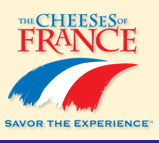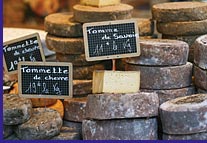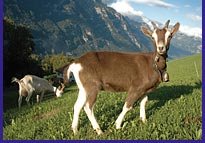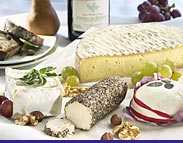 Nothing compares to well-made, perfectly ripened genuine chévre. French goat cheeses, or chévres, have been heralded worldwide, and they regularly top the popularity list of cheeses at U.S. cheese shops and counters. May begins the season when these fresh, soft cheeses come into ripeness, and their range of delicate tastes provide a pitch-perfect complement to the spring season.
Nothing compares to well-made, perfectly ripened genuine chévre. French goat cheeses, or chévres, have been heralded worldwide, and they regularly top the popularity list of cheeses at U.S. cheese shops and counters. May begins the season when these fresh, soft cheeses come into ripeness, and their range of delicate tastes provide a pitch-perfect complement to the spring season.
Goat cheeses are often known as “Loire Valley Cheeses” because they are frequently found in Poitou-Charentes in the France’s Loire Valley, although they are crafted in a number of the country’s regions. Typically loved for their pure, white “chalky” pâte, some consumers might be surprised by the range of flavors and textures exhibited by chévres, from delicate to rich, from semi-hard to gooey. Young, delicate chévres provide a perfect initiation for the beginning cheese lover who aspires to graduate to stronger tastes. For others, the exploration of the complex varieties across the spectrum can be a satisfying endeavor.
Some noteworthy chévres that don’t fit the typical pure white profile. Chevrotin des Aravis, for instance, has an off-white pâte and a musty, “goaty” finish; the exceptional Le Chevre Noir has a sweet taste and a firm white pâte, with an underlying crystalline texture that adds a hint of crunch to its full flavor. Selles-sur-Cher is often recognized as a quintessential Loire Valley chévre, as is Crottin de Chavignol, a semi-hard goat cheese that varies from mild to sharp. Chabichou du Poitou offers a clean, fresh taste of goat’s milk and a satisfying texture; Pouligny-Saint-Pierre is a pure white semi-soft cheese with complex notes that range from sweet to sour to salty, and Saint-Maure de Touraine, one of the more “goaty” cheeses, presents a more intense flavor.
There are many AOC varieties available; choose the flavor and mouthfeel that suits you best as you concoct the perfect platter to ease into the season.
Look Goat cheeses come in a variety of sizes and shapes including cones, cylinders, discs, drums, and pyramids. You’ll find Pouligny-Saint-Pierre in a pyramid shape, and Valençay, a classic mold-ripened creamy cheese with a rich texture, can be found in a flat topped four-sided pyramid. Mottled, blue mold on the rind is desirable and indicates the natural process of aging. Often, fuzzy white mold can be detected on the rind. The pâte can vary from the widely-known chalky white to off-white or yellow.
Selles, for example, can be found in round, slightly truncated small drums. Rinds are bluish gray with a dusting of white mold; the pâte should be a pure bone white. Crottin comes in small, flattened spheres that shrinks as it ages and develops a coating of grayish blue mold and fuzzy white areas; the pâte is off-white and dryish and is white toward the middle with a creamier, yellower striation toward the rind. Chevrotin des Aravis has a pinkish or orangish rind with a white powdery mold and an off-white pate.
Taste and Texture: Younger cheeses have less pronounced flavor, and are generally mild and creamy, whereas more aged chévre is drier and chalkier. Older chévres are slightly sharp with a lightly acidic flavor, but be aware that some can become too hard, too dry, or too “goaty” in flavor or aroma. Choose the level of aging that appeals to your taste, and ask you fromager whether you are tasting a younger or older chévre.
While Loire Valley cheeses are characteristically young and soft, they should not be too wet. A Selles, for instance, should feel firm and full and should exude a faint goat smell.
Packaging: Genuine goat’s milk cheese should be made entirely from goat’s milk. If you are purchasing at your grocery store, look for an indication of “Pur Chévre” on the label to ensure that the cheese is pure goat. Avoiding “commercial” goat cheese can be easily accomplished by steering away from fancy packaging that encases the cheese and eliminates the opportunity to see the rind and its elegant striations.
Store: Cheesemongers may extol the virtues of eating goat cheeses within 2-3 weeks of production, but large-scale production and export makes this ideal time frame a challenge. After purchase, cheeses will continue to ripen nicely for up to several weeks. Fresh chévre should be refrigerated at once and allowed to breathe by enclosing it in a lidded container or in a non-plastic wrap.
Serving: Goat cheese works well as an opener to a cheese course. The flavor of goat’s milk cheeses is complemented well by nuts — almonds or walnuts work well — olives, and non-citrus fruits such as berries.
Wine Pairing: Loire Valley goat cheeses such as the classic Selles-sur-Cher or Crottin de Chavignol pair extremely well with French Loire Valley Sancerre. Other fine choices include Pouilly Fume, Red Beaujolais, Light Pinot Noirs and Dry Champagnes.






